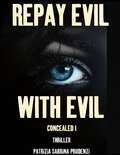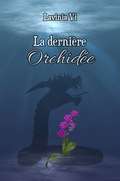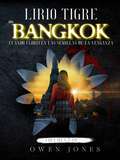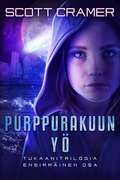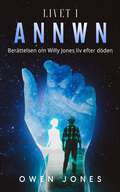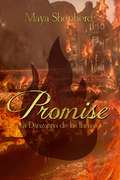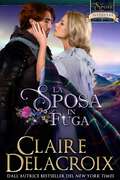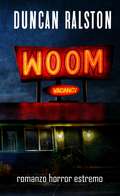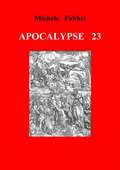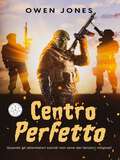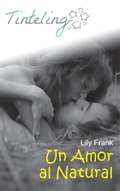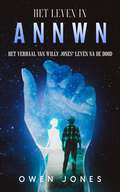- Table View
- List View
Hipnosis Básica: Una guía completa para la hipnosis.
by Lena SheehanEste libro de autoayuda es ideal para los estudiantes principiantes que buscan hipnosis como profesión o para los curiosos recientes que buscan formas de mejorar. Los contenidos informativos y fáciles de entender incluyen inducciones de muestra para las situaciones más comunes para ayudar al lector a comenzar. Dentro de estas páginas aprenderá los conceptos básicos sobre la hipnosis; desde su historia hasta cómo realizar una sesión de hipnosis estándar. Se proporcionan guiones reales, junto con sugerencias sobre cómo crear guiones diseñados para sus necesidades específicas e individuales. Ya sea que prefiera la hipnosis consciente o una inducción de hipnosis tradicional, este libro le proporciona las herramientas para ayudarlo a cambiar los pensamientos de usted y la vida de los demás. "Somos lo que pensamos." Buda ¡Cambia tus pensamientos, cambia tu vida!
Concealed I: Book 2 (Repay Evil with Evil #2)
by Patrizia Sabrina PrudenziThere are things that should be kept hidden forever. Julia is young, beautiful and will soon inherit an immense fortune. But she has a horrible secret. David loves her dearly, but if he would know the truth, then there would be no future together more. Worse still, she would be locked up for the rest of her life. Her only option is to hide the secret from David and everyone else. At first she succeeds well. Until someone endangers her life ...
El infierno está cerca
by N. P. Martin"El infierno está vacio y todos los demonios están aquí." Leia Swanson es una chica huérfana que acaba de cumplir los dieciocho años y dejar atrás un pasado turbulento en el que perdió a sus padres con sólo siete años. Entonces, la gente empieza a convertirse en demonio ante sus ojos y ella comienza a sentir un poder extraño creciendo en su interior. Después de visitar la casa de su infancia, la vida de Leia dará un giro. Convencida de que un demonio se llevó a su madre y mató a su padre, Leia descubre el verdadero pasado de su madre: una Vigilante (cazador de demonios) y que ella también es una Nephilim (mitad ángel, mitad humana). Cuando alguien secuestra a su hermano gemelo Josh y mata a su madre de acogida, Leia se ve obligada a encontrar a Frank, su tío, del que nadie le había contado nada. A pesar de ser un hombre solitario, Frank accede a enseñar a Leia a utilizar sus poderes de Vigilante y ayudarla a rescatar a su hermano. En el camino, Leia podrá desentrañar ese pasado oscuro. Mientras tanto, un poderoso demonio ha secuestrado a niños Nephilim de todo el mundo para involucrarlos en un malvado plan que pondrá en peligro la tierra. El infierno está cerca. ¿Será capaz Leia de dar su vida y, posiblemente, su alma para salvar al mundo? El infierno está cerca es el primer libro de la saga Los Vigilantes. Si le gustan los thriller supernaturales, descargue un fragmento o compre El infierno está cerca.
La dernière Orchidée: Roman de Fantaisie Urbaine sur une jeune fille au passé mystérieux capable de rêver l'avenir.
by Lavinia ViLa vie d'Anthea Grage est apparemment normale. Elle vit à Portown, une petite ville du Maine, elle a une famille qui l'aime et une inséparable meilleure amie, Lyv, la seule à connaître son sombre secret. Personne d'autre ne sait qu'au plus profond de la nuit les rêves d'Anthea ne sont pas peuplés de peurs et de désirs mais de l'empreinte d'événements qui doivent se produire. Lorsque l'un de ces rêves prémonitoires lui annonce l'arrivée en ville d'un jeune homme mystérieux et très beau, Noah Shane, sa routine ennuyeuse est complètement chamboulée. La jeune fille se retrouve tout à coup contrainte de remettre en question tout ce à quoi elle a cru jusqu'à présent. Des parties obscures de son passé frappent avec insistance à la porte afin de redevenir d'actualité et Caleb Shane, le cousin grincheux de Noah, semble connaître des choses qu'elle ignore et qu'elle veut découvrir à tout prix. Anthea parviendra-t-elle à découvrir ses véritables origines... et à y survivre?
Lirio Tigre de Bangkok: Cuando florecen las semillas de la venganza (Lirio Tigre de Bangkok #1)
by Owen JonesLirio Tigre de Bangkok Cuando florecen las semillas de la venganza Lily nació en una tranquila aldea al noreste de Tailandia, cerca del Río Mekong y en la frontera con Laos, en una familia china, propietarios de una tienda. Ella tuvo una infancia muy feliz, hasta que, a la edad de once años un viejo amigo de la familia, que ayudaba a sus padres en la tienda, comenzó a abusar de ella. A ella le tomó dos años encontrar una solución y ésta surgió de un evento fortuito en el patio de su escuela. Ella vio una película porno que algunos muchachos estaban mirando en su iPad, y que tenía que ver con sexo oral. La siguiente vez que él la tocó, ella le ofreció hacer lo que había visto en la película. El hombre no despreció la oportunidad. Lily le arrancó el pene y se lo dio a comer a sus gallinas en el patio. No obstante, esto solo convirtió una forma de tormento en otra, porque la gente ahora la rechazaba, impactada por lo que ella había sido capaz de hacer. Ella se convirtió en una marginada y contaba los días en que ella pudiera tener la oportunidad de irse a estudiar en Bangkok, usando el dinero que le dieron como compensación del abuso que había sufrido. Ella no conocía a nadie en Bangkok y no estaba acostumbrada a las grandes ciudades, así que comenzó a rondar a una variedad de hombres, a quienes iba por compañía y por el dinero, ya que le quedó claro que lo que ella tenía era una fortuna en su aldea, pero no era suficiente para cubrir sus años de universidad. Ella tenía cuatro novios regulares, pero no le gustaba ninguno de ellos y sospechaba que algunos era pervertidos también, porque a ellos les gustaba vestirla como a una colegiala, un papel que podía asumir con facilidad porque ella era en cierto modo pequeña y delgada. Fácilmente podía pasar por una chica de trece sin maquillaje, incluso cuando tenía dieciocho años. A la mayoría de sus novios les
Purppurakuun yö
by Scott CramerAbby odottaa, että voi katsella kuun muuttuvan violetiksi tietämättä, että maan ohi kulkeva komeetta tuo mukanaan bakteereja, jotka tappavat pian kaikki vanhemmat teini-ikäiset ja aikuiset. Hänen pitää auttaa veljeään ja pientä siskoaan selviämään tässä uudessa maailmassa, mutta samaan aikaan hänen sisällään tikittää aikapommi – murrosikä. Tukaani-sarjalla on tuhat viiden tähden arviota. Dystopiadraama, joka on yhtä aikaa ”pelottava ja inspiroiva”.
Repay Evil with Evil: Book 1
by Patrizia Sabrina PrudenziDid I really kill everyone? I don't know. Why can't I remember? The young Julia Walz gets into trouble. She is suspected of having committed a series of brutal murders. Her biggest problem: she doesn't know because she is suffering from memory disorders due to a childhood trauma. Only the handsome inspector David Nyomda believes her. When he finds clues to a gruesome secret in Julia's past, he puts himself in danger in order to help her. Forgive or repay? Sometimes you have no choice when the past is too terrible …
Bezorg je hond een echte hondenleven: en laat hem dol zijn op jou!
by Owen Jones‘Bezorg je hond een echte hondenleven – en laat hem dol op je zijn’ is het volledige handboek voor het kiezen en kopen van een hond en om een band met een hond te smeden en voor hem te zorgen. Dit boek is geschreven door een hondeneigenaar die zo gek is op honden dat zijn vrouw er zeker van is dat hij een hond was in een vorig leven! Owen Jones heeft zijn leven sinds de eerste dag met honden gedeeld. Hij kent zo goed dat hij zeker is dat hij hen grappen kan vertellen! Dit boek moet je lezen!
Livet i Annwn: Berättelsen om Willy Jones liv efter döden (Annwn – Himlen #2)
by Owen JonesLivet i Annwn Berättelsen om Willy´s liv i himmeln Livet i Annwn fortsätter direkt där boken "En natt i Annwn" slutade. Willy har gått över till andra sidan, och han är äntligen återförenad med sin fru som han har saknat i över ett decennium, hans älskade Sarah. Men till att börja med så är livet i Annwn, det gamla walesiska ordet för himlen, inte vad han hade förväntat sig då han bodde på jorden eller ytan, som hans fru kallar det, eftersom Annwn är underjordisk. Hans första överraskning kommer när Sarah tar honom till ett värdshus för att återhämta sig från påfrestningen kring hans begravning, men det slutar inte där. Varje dag avslöjar nya överraskningar, tills den mystiska blockeringen försvinner och han upplever livet efter döden som det verkligen är. "Livet i Annwn" är en överraskning i sig, men det är också en komisk titt på en alternativ verklighet, som faktiskt kan vara närmare sanningen än någonting annat du någonsin har läst! "Livet i Annwn" är en bok som du måste läsa eftersom den kan förändra hur du ser på livet för all framtid..
Promise 2 - La Danzarina de las Llamas: La Danzarina de las Llamas
by Maya Shepherd Marina - de Puig - SmirnovaHace poco que Nea había escapado de la muerte por fuego. Irónicamente su mejor amigo Miro, que ella cree muerto, se ha salvado. Pero ya no es el mismo, porque él es venerado por los Carris como el Dios del Caos. Nea no sabe si todavía puede confiar en él. Además, en esta secta pasan cosas muy extrañas. Los seguidores de los Carris, que no son los más cercanos a Urelitas, se comportan como zombis. Junto con sus amigos, Nea desarrolla un plan de fuga. ¿Estará Miro de su lado? ¿Podrá contar con la ayuda de Arras? "La Danzarina de las Llamas" es el segundo volumen de una trilogía. El título del primer volumen es "La cazadora de Osos."
Tres Días En El Cielo
by Mark Anthony WatersDespués de un ataque al corazón, el abogado Tony Stanford se encuentra no en este mundo, sino en un campo de golf celestial. No está listo para creer que está muerto, su esposa, sus mejores amigos y los médicos trabajan contra el tiempo para demostrarle a la junta del hospital que realmente no se ha ido. Incluso con sus temas religiosos, Three Days In Heaven es una historia que una persona de cualquier fe puede disfrutar. La cirugía a corazón abierto, la muerte y el encuentro con Dios parecen ser temas serios, pero el libro trata sobre ellos de una manera alegre y creíble.
La sposa in fuga (Le spose di Inverfyre #2)
by Claire DelacroixAoife MacNeill è una bellezza, un trofeo da conquistare. Ora che non è più un’ereditiera, vorrebbe sposarsi per amore, ma suo padre ha organizzato il suo matrimonio con Nigel Armstrong, figlio maggiore ed erede del Falco di Inverfyre. Le basta uno sguardo per capire che Nigel non conquisterà mai il suo cuore, ma suo cugino, Ross di Kinfairlie, è tutta un'altra storia. Aoife sa che non può sfuggire al suo destino, eppure desidera ardentemente tentare la sua ultima carta: fuggire da Inverfyre e sperare che Ross venga mandato al suo inseguimento. Sarà sufficiente un bacio... Ross di Kinfairlie è un mercenario che mette la sua spada al servizio dei signori, un cavaliere privo dei beni necessari per poter reclamare una sposa. Quando la fidanzata del cugino scappa, corre al suo inseguimento perchè sa di dovere qualcosa al Falco che lo ha addestrato. Ross sospetta che Aoife non sia consapevole dei rischi che corre e infatti l'infido clan dei MacLaren, che cerca da sempre di danneggiare Inverfyre, la fa prigioniera. Durante il salvataggio, Ross si ritrova affascinato dalla bella e selvaggia fanciulla. Quanto sarà disposto a cedere Ross per garantire la sicurezza di Aoife? E quanto rischierà Aoife per proteggere l'uomo che ha catturato il suo cuore?
デッド センター: 自爆テロ、すべテガ宗教テロとは限らない! (デッド センター #1)
by オーウェン ジョーンズ世界各地で頻発する爆破事件。宗教的な自爆テロなのか? 対応を迫られた警察が事件の真相を追い求めて操作を開始する。イラクで、イギリスで、フランスで、アメリカで・・・。自爆犯は白人だった。肌を染め、変装して、操作を撹乱する。はたしてその意図は? 個々に操作に当たっていた警察が次第に連携を取り始める。防犯カメラに映された映像に現れ始める証拠が、点から線へ、次第に結びつき、形を作り始める。一方、犯人像はなかなか明らかにならない。動機は何なのか? ただの自殺行為なのか? あるいは復讐なのか? 各地に起こる犯罪を裏で操作している組織が存在するのか? 「デッド・センター」とはいったい何なのか? 想定外の展開が・・・。読み始めたらページをめくる手が止まらない。一気に読み切ってしまいたくなる長編サスペンス!
El Precio para Amar (Los Friessen: Un Nuevo Comienzo #2)
by Lorhainne EckhartElla podía darle todo excepto lo único que quería: un hijo. Candy sabe que su marido quiere un bebé, pero ella no
Woom
by Duncan RalstonUn thriller psicologico feroce e trasgressivo, per gli amanti di Chuck Palahniuk e Lars von Trier. Attenzione: questo libro contiene scene esplicite di violenza e sesso che normalmente vengono ritenute offensive. «Non so,» disse Angel. «Io credo che sia la sofferenza a rimanere sospesa. Se credo agli spiriti, al soprannaturale? Probabilmente no.» Il Lonely Motel nasconde segreti terribili e la stanza numero sei contiene forse quello peggiore di tutti. Angel sa tutto sul dolore. Sua madre è morta lì. Ha fatto ricerche sulla storia di quella stanza. Ora è tornato per mettere la parola fine, a qualsiasi costo, una volta per tutte. Shyla, una prostituta di taglia forte, pensa che le storie di Angel non siano vere. Segreti talmente disgustosi che nessuno vorrebbe scoprire. Ma il Lonely Motel non dimentica. Non perdona. E reclama sempre la sua vittima.
Apocalypse 23
by Michele FabbriUne compilation de poésie obscure et inquiétante: qui habet aurem audiat...
Å temme Chloe Summers (Bad boys to lovers #2)
by Anna KatmoreNår en ulv og en tiger leker i skogene ... Jeg skulle ha vært på et fly til London for et fantastisk andre college-år der. I stedet sitter jeg fast i Froskedamfjellet, som veileder for en horde pubertale tenåringer, bare fordi jeg hadde noen mindre uoverensstemmelser med loven. Men jeg kom jo hit med en plan: Neste helg stikker jeg fra bondetampene og lurer meg tilbake til sivilasjonen. Uheldigvis klarte ikke min briljante plan B å forutse en liten, men ganske hot detalj: Justin Andrews, leder for ulvegruppen.
Centro Perfetto: Quando gli attentatori suicidi non sono dei fanatici religiosi! (Centro Perfetto #1)
by Owen JonesCentro Perfetto Quando gli attentatori suicidi non sono dei fanatici religiosi! Quando un kamikaze si fa esplodere allo Sheherazade, un grande magazzino di Baghdad, la reazione delle autorità irachene è di considerarlo un normale atto di terrorismo e assegnare il caso al capitano Allawi della polizia nazionale irachena. Mentre ispeziona abitualmente le riprese video delle telecamere di sicurezza, un giovane poliziotto con la vista acuta nota che l’attentatore suicida non è quello che vuole far credere, e questo da una svolta all’indagine in una direzione che nessuno aveva mai considerato possibile prima. Le conseguenze di questa nuova forma di terrorismo sono terribili. Poi, in un breve lasso di tempo, si verificano altri sei crimini che coinvolgono attentatori suicidi, inspiegabili a meno che non siano visti alla stessa luce dell’attentato di Baghdad. Questo porta le forze di polizia di Marsiglia, Essen, Belfast, New York, Londra e Los Boliches a lavorare insieme sotto l’egida dell’Interpol per mettere fine a questa nuova banda criminale. Una svolta arriva quando la polizia si rende conto che ci sono diversi moventi per gli attentati suicidi, ma dal momento che i colpevoli sono imprevedibili, arrestarli diventa impossibile. L’unica tattica percorribile è concentrarsi sul metodo di ricerca degli attentatori, anche se ovviamente muoiono tutti nelle incursioni. Il caso inizia a sembrare senza speranza. Nonostante numerose piccole svolte, le forze di polizia congiunte, a capo del capitano Allawi, non riescono a compiere importanti progressi, quindi chiedono al governo cinese l’assistenza dei loro esperti di Internet, perché si ritiene che siano i migliori al mondo. I cinesi, con l’ausilio delle autorità lettoni e argentine, rintracciano il probabile quartier generale della banda nell’Inghilterra occidentale, e quando i loro omologhi britannici esaminano i dati
Un amor al natural
by Lily FrankDespués de la dolorosa ruptura de su relación, Robin necesita unos días de vacaciones. Entonces, se deja llevar por su querida amiga Brenda a Francia. La primera sorpresa que recibe, es que Brenda ha reservado un camping naturista. Conocer al guapísimo (y, sobre todo desnudo) Ned, es la segunda sorpresa. Robin no tiene ninguna relación con el nudismo. Pero quizás es Ned quien la convence de entregarse, desnuda como cuando llegó a este mundo. ¿Puede el amor, mismo sin la ropa puesta, salir indemne de la batalla?
Harper Jones: 1. The Curse (Harper Jones #1)
by Blandine P. MartinI live to wipe out his kind. But he might be my last hope. I am Harper Jones, a specialist in occult sciences and a vampire hunter. My childhood conditioned me to hate them and hunt them down, and for years I have worked towards one single goal: avenging my family. When a series of suspicious murders terrifies London, I redouble my efforts to rid the city of monsters, even if this means joining forces with my worst enemies. Their condition: a chaperon of their choosing. A certain Lysandre, another vampire, a master in the art of making things hard for me. But this is not the most disturbing aspect of my life. Something is dormant within me: a darkness that is taking me over, swallowing me up… Why does this vampire seem to know about the evil eating away at me? What does he know about my past? This quest for the truth might very well cost me my soul, along with my heart.
Het Leven in Annwn: Het Verhaal van Willy’s Leven In de Hemel (Annwn-Hemel #2)
by Owen JonesHet Leven in Annwn Het Verhaal van Willy’s Leven In de Hemel Het Leven in Annwn vervolgt precies waar Een Nacht in Annwn ophield. Willy is overgegaan en hij is eindelijk bij de voruw die hij een decennium of meer heeft gemist, zijn geliefde Sarah. Maar meteen van het begin is het leven in Annwn, het oeroude Welshe woord voor de Hemel, niet wat hij had verwacht gedurende zowat zijn hele leven op Aarde, of De Oppervlakte, zoals zij het noemt, daar Annwn ondergronds is. Zijn eerste verrassing komt wanneer Sarah hem naar een herberg brengt om bij te komen van de beproeving van zijn begrafenis, maar daar houdt het niet op. Elke ‘dag’ brengt nieuwe verrassingen, tot dat wat mysterieus De Blokkering wordt genoemd, wegvalt en hij het Leven Na de Dood ervaart zoals het echt is. Het Leven in Annwn is een varrassing op zichzelf, maar het is ook een komische kijk op een alternatieve werkelijkheid die wel eens dichter bij De Waarheid zou kunnen liggen dan wat u ooit hebt gelezen! Het Leven in Annwn moet je lezen, want het zou de manier waarop u de dingen bekijkt voor atijd kunnen veranderen.
Mi Vampiro Secreto
by Anna KatmoreDurante diecinueve años, fui un tipo normal de California. Hasta que un accidente de coche casi me mata, y el Conde Drácula decidió hincarme sus colmillos en la garganta. Al ser su tatara-tatara-sobrino y su legítimo heredero, me envió a la maldita Transilvania para aprender a ser un vampiro de la manera más difícil: sin personal para comer, sin posibilidad de escapar y sin Wi-Fi. Es el sitio perfecto para volverse loco. Y morir de hambre. Sin embargo, hay una chica... Abigail. Por alguna razón, le gusta vagar por el oscuro y mohoso castillo. Dice no saber nada de vampiros, pero juro que intenta matarme cada vez que nos encontramos. La habría invitado a ser mi cena anoche si no hubiera huido con algo muy preciado para mí: mi colmillo. Es por eso que estoy esperando a que anochezca para encontrarla y recuperar mi diente. Después, mataré al hombre lobo que ronda en el bosque, ya que es la única condición que me puso el tío Vlad para regresar a casa. Para mi mala suerte, la caceria del lobo resultó ser más difícil de lo que esperaba. Además, el olor a galletas de Abigail provoca que quiera hacer cosas estúpidas...
Apocalypse 23
by Michele Fabbri"Apocalypse 23" has won numerous literary awards and has been welcomed by critics. It has became a cult book thanks to bookcrossing as has long been the first book in the ranking of "most traveled" and still is the first Italian book in standings.
La hija del mar y el cielo
by David LitwackUna mirada a la línea entre fe y fantasía, fanáticos y seguidores, y religión y razón, que incitará a la reflexión. GANADOR: Pinnacle Book Achievement Award, Otoño 2014 - Mejor fantasía GANADOR: Awesome Indies Seal of Excellence “Solo hay dos formas de vivir la vida. Una es como si nada fuese un milagro. La otra es como si todo fuera un milagro.” ~ Albert Einstein Hijos de la República, Helena y Jason eran inseparables en su juventud, hasta que el destino los envió por caminos distintos. El dolor y el deber desviaron los planes de Helena, y Jason llegó a detestar la vacuidad de sus propias ambiciones. Estas dos almas dañadas se reúnen cuando un pequeño barco de las Tierras Sagradas se estrella contra las rocas cerca de casa de Helena, tras un imposible viaje a través del océano prohibido. A bordo hay un solo pasajero, una niña de nueve años de nombre Kailani, que se hace llamar La hija del mar y el cielo. Un nuevo y peligroso propósito ata nuevamente a Jason y Helena, pues juran proteger a la inocente perdida de la ira de las autoridades, sin importar el riesgo a su futuro y libertad. Pero ¿es la misteriosa niña simplemente una pequeña perturbada que anhela volver a casa? ¿O es una poderosa profeta enviada a desenredar los hilos de una República sin dios, como quiere hacerles creer el líder forajido de una secta religiosa ilegal? Cualquiera que sea la respuesta, los cambiará para siempre… y tal vez también a su mundo. "...una lectura apasionante, bien imaginada...." ~ Kirkus Reviews "El autor David Litwack entreteje graciosamente su mensaje con hilos alternativos de lo fantástico y lo realista… El lector hallará sabiduría y gracia en esta historia bellamente escrita." ~ San Francisco Book Review Evolved Publishing presenta la saga literaria de una niña arrancada del mar bajo
Die Weihnachtsliste der Hexen: Verhexte Westwick-Krimis (Verhexte Westwick-Krimis #4)
by Colleen CrossEssen, Trinken und .... oh je ... Cendrine West freut sich auf ein gemütliches Weihnachtsessen, während draußen ein Schneesturm wütet und eine Flut unerwarteter Gäste ins Haus bringt. Aber beschwipste Hexen und schelmische Magie ist das beste Rezept für eine Katastrophe, vor allem, als plötzlich einer der Gäste das Zeitliche segnet. Cens Detektivarbeit deckt einen Sack voller Ärger auf, und jeder ist verdächtig, sogar ihr gutaussehender Freund, der Sheriff. War es ein tödlicher Unfall durch eine betrunkene Hexe ... oder etwas Schrecklicheres? Mord steht auf der Speisekarte und nur Zauberei kann die Wahrheit in dieser hexenhaften, verrückten und aufregenden Fahrt in die Weihnachtszeit ans Licht bringen! Die Verhexten Westwick-Krimis sind für Fans von unterhaltsamen Krimis Schuss Humor und etwas Zauberkraft.

